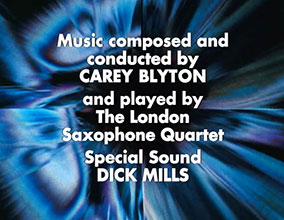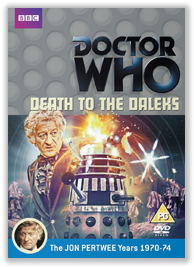Doctor Who has become a massive global success in recent years after the BBC took its long-running low-budget sci-fi series, reinvented it for a modern audience and sold it like mad around the world. But decades ago, long before Doctor Who became all special effects and glitz, it was greatly admired for its interesting, inventive stories, its quirky touches of offbeat humour and its often genuinely scary atmosphere, which it frequently managed to achieve in spite of its often comically low-budget sets, costumes and special effects. This was the classic era of Doctor Who, and it was during this period, with Jon Pertwee and then Tom Baker starring as the Doctor, that Carey Blyton was commissioned to write the music for three serials:
- Doctor Who and the Silurians (1969/1970)
- Death to the Daleks (1974)
- Revenge of the Cybermen (1975)
 Doctor Who: Death to the Daleks
Doctor Who: Death to the Daleks
Carey’s musical notes
The action of this story takes place on the planet Exxilon, inhabited by the remnants of a once civilised and sophisticated race now reduced to an almost Stone Age existence, worshipping an ancient self-perpetuating, self-repairing City in rituals involving human sacrifice and a form of dog Latin. Daleks are on Exxilon to obtain parrinium, a rare chemical element, as are the crew of a Marine Space Corps spaceship. But whereas the MSC spaceship is after parrinium to combat a disease which is ravaging outer world colonies, the Daleks require it for a very different – and devastating – purpose. Doctor Who and his companions frustrate the Daleks’ plans, assisted by friendly Exxilons who are part of a revolution to overthrow the High Priest and all that he stands for.
The music, scored for soprano saxophone/E flat, B flat and contrabass clarinets/basset horn (one player), alto saxophone/E flat and B flat clarinets/basset horn (one player), tenor saxophone/flute/B flat and bass clarinets (one player), baritone saxophone/B flat and bass clarinets (one player), percussion and solo tenor voice, was played by the members of the London Saxophone Quartet. By means of multiple recordings and superimposition, Dick Mills of the BBC Radiophonic Workshop was able to build up a whole ‘choir’ from the solo voice of the Welsh tenor, Mostyn Evans. The music runs for 20 minutes.
- A Desolate Landscape
- Exxilon Chant 1(see below)
- Dalek ‘March’ (followed by silence)
- Dalek ‘March’ (conclusion)
- Exxilon Chant (human sacrifice)
- The fight in the caves between Daleks and Exxilons
- The fight between the Daleks and the City’s ‘zombies’—the Daleks are routed
Exxilon Chant 1
The following is a sample of the ‘dog Latin’ used by the Exxilons in their somewhat unpleasant rituals involving human sacrifice:
- 1. Ex surge quare obdormis shuba?
- Ex surge et ne repellas finem:
- Quare faciem tu am avertis,
- Oblivisceris tribulationem nostram.
- 2. Admæ sit in terra venter noster:
- Ex surge shuba adjuvanosti
- Shuba auribus nostris audivimus
- Patres nostri annunti averunt nobis.
- Ayluja! Ayluja!
It never became apparent why a race of beings on a planet in a remote corner of the galaxy knew any form of Latin. Perhaps a space probe from Earth had landed there eons before, carrying a prayer for peace!
—Carey Blyton, 2002
Recordings: The extracts from the original incidental music presented on this page are taken from the CD, Carey Blyton: Film & Television Music (2/4); The Film Production Music (which is available for purchase from this site).
Concert Suite
In the mid-1990s, nearly two decades after writing the music for Death to the Daleks, Carey Blyton derived a short three-movement work for concert performance from it: his Dalek Suite for Saxophone Quartet, op. 103 (1993). This resulted from an approach made to Alec Gould of AV Music with the idea of writing three little suites derived from the music from the serials; the response was enthusiastic, so the suites were quickly produced and published. The following text is taken from the notes accompanying the original edition:
Movements
- A Desolate Landscape
- Chants & Variants
- Dalek ‘March’ & Retreat
These three pieces are derived from the incidental music I wrote for Death to the Daleks (BBC-tv, 1974), the second of the three Doctor Who serials for which I provided background scores. The story, by Terry Nation, the creator of the Daleks, is acted out on the planet Exxilon, inhabited by the remnants of a once highly advanced people, now reduced to a primitive, almost Stone Age, race worshipping the sophisticated, self-perpetuating City built by their ancestors, to which they make human sacrifices.
Doctor Who (Jon Pertwee) and his companion have landed on Exxilon in error, and are unable to leave as all power is being drained by the City’s beacon. They discover the crew of a Marine Space Corps ship, also unable to leave because of the power loss. They are on Exxilon to get parrinium, a rare chemical element common on Exxilon, desperately needed to combat a disease which is ravaging the outer worlds, where colonists are dying in their thousands.
Daleks then arrive. They, too, are after parrinium, although for less humane purposes… The drama is then played out, in which the Doctor and his companions finally emerge victorious. They are assisted by friendly Exxilons who are part of a revolution to overthrow the High Priest and all that he stands for.
The music was scored for saxophone quartet (played by the London Saxophone Quartet) and percussion (one player), with the following doublings:
- SOPRANO SAXOPHONE: doubling 2nd E flat Clarinet, 2nd B flat Clarinet, 2nd Basset Horn & Contrabass Clarinet in B flat
- ALTO SAXOPHONE: doubling 1st E flat Clarinet, 1st B flat Clarinet & 1st Basset Horn
- TENOR SAXOPHONE: doubling 3rd B flat Clarinet, 1st Bass Clarinet in B flat & Flute
- BARITONE SAXOPHONE: doubling 4th B flat Clarinet & 2nd Bass Clarinet in B flat
In the original scoring, the music associated with the Daleks (increasingly ‘wobbulated’ as the serial proceeded) was most usually heard on two Basset Horns and two Bass Clarinets, while that associated with the Exxilons and the City was most usually heard on saxophone quartet. Much of the music was derived from the chants (with their ‘dog Latin’ texts) used by the Exxilons in their religious rituals involving human sacrifice.
The titles of the three movements are self-explanatory.
 For those who remain young at heart, this Doctor Who serial has been issued as a home video, available from BBC Enterprises (BBCV 4073) or through the usual retail channels.
For those who remain young at heart, this Doctor Who serial has been issued as a home video, available from BBC Enterprises (BBCV 4073) or through the usual retail channels.
—Carey Blyton
Swanley, 9/6/1993
Video update: Doctor Who: Death to the Daleks is now available on DVD (BBCDVD 3483).
Musical comparison
As an interesting comparison, here are two versions of the same music. The first extract, from the original incidental music score, is the ‘wobbulated’ recording of the Dalek ‘March’ & Retreat (presented separately above). This music was adapted quite freely and combined with other elements to produce the third movement of the Dalek Suite; although both the original score and the Suite arrangement are for basically the same set of instruments, the treatment of the music is very different, with the newer Suite being far more upbeat and jaunty than the ponderous and menacing original. The Suite version has also been given a comical ‘fleeing in panic’ ending! Here are the two versions to compare:
- Original incidental music: Dalek ‘March’ & Retreat (‘wobbulated’)
- Dalek Suite, third movement: Dalek ‘March’ & Retreat
Recording: The extract from the Dalek Suite is performed by the Phoenix Saxophone Quartet and is taken from the CD, Carey Blyton: Sherlock Holmes meets Doctor Who (which is available for purchase from this site).
Recollections of the production
The DVD release of Doctor Who: Death to the Daleks contains a documentary called Beneath the City of the Exxilons: Making “Death to the Daleks”. This contains a segment in which Nick Briggs, Executive Producer at Big Finish and voice of the Daleks in the modern Doctor Who series, recalls how very influential Carey Blyton’s score for Death to the Daleks was on him in his youth:
”
“
The music in this story was done by Carey Blyton, who had previously done Doctor Who and the Silurians, and he had a brilliant way of making weird noises with conventional instruments. It doesn’t say, “This is dramatic;” it goes: “Weird!” It says, “Weirdness, strangeness,” and I think that’s different from a lot of what Doctor Who was doing at the time. You know, you had them chanting and doing that fantastic tune [sings]. That was the first thing I ever learnt to play on an instrument, you know that? I had a little penny whistle that I bought on holiday, and I learnt to play [sings the chant melody]. How about that, eh? Most people learn London’s Burning, but I learnt that!
Reviews
…another remarkable score…
All in all, a highly original score which stood out in sharp contrast to the usual radiophonic blancmange which accompanies the majority of Doctor Who serials.
A brilliant touch … was that the music associated with the Daleks sounded like Dalek music—it had the same quality and ‘wobble’ as Dalek speech. This was one of the few radiophonic touches in the whole score: in the hands of a master, a little does indeed go a very long way.
I for one appreciated what I can only describe as the ‘Exxilon Chant’—a most hypnotic kind of primitive chant based on what seemed to be some sort of dog Latin text: I understand that this imposing edifice of choral sound was built up entirely from a solo voice … another example of a little going a long way, with a vengeance!
…he had a brilliant way of making weird noises with conventional instruments. …you had them chanting and doing that fantastic tune … That was the first thing I ever learnt to play on an instrument, you know that? … Most people learn London’s Burning, but I learnt that!


Doctor Who story in four 25-minute episodes
Written by Terry Nation
Directed by Michael E. Briant
Produced by Barry Letts
Incidental music by Carey Blyton
Incidental music duration: 20 minutes
Performed by the London Saxophone Quartet
Produced in 1974 by BBC-tv
Broadcast on BBC1 from 23rd February to 16th March 1974
Available on DVD: BBCDVD 3483